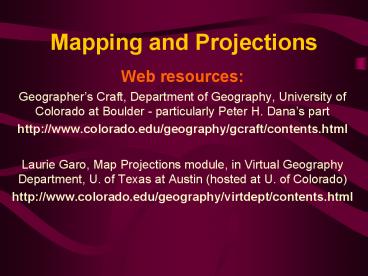Mapping and Projections - PowerPoint PPT Presentation
1 / 43
Title:
Mapping and Projections
Description:
Laurie Garo, Map Projections module, in Virtual Geography Department, U. of ... Often used for world maps. Pseudocylindrical Projection. Pseudocylindrical Projection ... – PowerPoint PPT presentation
Number of Views:199
Avg rating:3.0/5.0
Title: Mapping and Projections
1
Mapping and Projections
- Web resources
- Geographers Craft, Department of Geography,
University of Colorado at Boulder - particularly
Peter H. Danas part - http//www.colorado.edu/geography/gcraft/contents.
html - Laurie Garo, Map Projections module, in Virtual
Geography Department, U. of Texas at Austin
(hosted at U. of Colorado) - http//www.colorado.edu/geography/virtdept/content
s.html
2
Map Projections
- Basic problem
- Earth is round
- Paper is flat
3
Conformal
4
Equivalent or Equal Area
5
Equidistant
6
Equidistant CylindricalMap from Carlo Futuri
7
Solving the Problem
- How do you represent a curved surface on a flat
surface? - Bonehead way - just plot latitude vs. longitude
as cartesian rectangular coordinates - Projection - fit a flat surface around (or
through) a sphere, and trace the pertinent
information on it
8
Unprojected map
9
Types of projections
- Three main families
- Cylindrical - wrap sheet of paper around globe in
cylinder shape - Also pseudocylindrical - like cylindrical but the
sheet of paper bends inward at the poles - Conic - form sheet of paper into a cone and
insert globe - Also polyconic - multiple cones
- Azimuthal - place flat sheet of paper next to
globe project features out onto it
10
Cylindrical Projection
11
Cylindrical Projection
- Formed by wrapping a large, flat plane around the
globe to form a cylinder. - Transfer latitude, longitude, shapes onto
cylinder, then unfolded into a flat plane. - Typically used to represent the entire world
often projected from center of globe with equator
as tangent line - Most types show parallels and meridians forming
straight perpendicular lines.
12
Cylindrical Projection
13
Pseudocylindrical Projection
- Projection surface is not rectangular
- Instead, it curves inwards at the poles.
- Latitude lines are straight central meridian is
straight, but other meridians are curved (concave
toward the central meridian). - Often used for world maps
14
Pseudocylindrical Projection
15
Pseudocylindrical Projection
16
Pseudocylindrical Projection
17
Conic Projection
18
Conic Projection
- Points from the globe are transferred to a cone
fit around the sphere. - Usually, the pointy end of the cone is directly
over the north or south pole, but you can do it
anywhere. - Can represent both hemispheres, but distortion
increases the farther along the cone you go
19
Conic Projection
- Often used to project areas that have a greater
east-west extent than north-south, e.g., the
United States. - When projected from the center of the globe,
conic projections typically show parallels
forming arcs concave toward the North or South
pole, and meridians are either straight or curved
and radiate outwards from the direction of the
point of the cone.
20
Conic Projection
21
Equidistant Conic Projection
22
Albers Equal Area Conic
23
Polyconic Projection
- Complex projection, used originally by USGS for
quadrangle maps of U.S. - Uses an infinite number of cones applied to an
infinite number of tangents across a given
hemisphere - Reduces distortion, but harder to conceptualize
and produce
24
Polyconic Projection
25
Polyconic Projection(centered at equator, 90ºW)
26
Azimuthal (Planar) Projection
27
Azimuthal or Planar Projection
- Globe grid is projected onto a flat plane
- Plane is normally placed above the north or south
pole, so normally only one hemisphere, or a
portion of it, is represented - When projected from the center of the globe, a
typical polar azimuthal projection shows circular
latitude lines with radiating longitude lines
28
Azimuthal Projection
29
Azimuthal Projection
30
Oblique Azimuthal Projection
Orthographic sort of means viewed from infinite
distance
31
Types of projections
- Tangent
- Flat surface only touches globe along one
circular line (or at one point for Azimuthal) - Secant
- Flat surface passes through globe touches
surface at two circular lines (or in one circle
for Azimuthal) - Some projection is inward rather than outward
- Reduces distortion of large areas
32
Tangent Projection
33
Secant Projection
34
Secant Projection
35
Robinson Projection
36
Goodes Interrupted Homolosine Projection
37
Tissot indicators
- Tissots idea - to see the effects of distortion,
show what shape small circles on the surface of
the globe take after projection - This shows shape, scale, area, and other
distortions
38
Tissot Indicators Mercator (Conformal)
Image from http//quantdec.com/tissot
39
Tissot Indicators Peters Equal Area
Image from http//quantdec.com/tissot
40
Tissot Indicators Azimuthal Equidistant
Image from http//quantdec.com/tissot
41
Tissot Indicators
42
Silly Projections
43
Web sites to visit
- http//www.guilford.edu/geology/Geo340.html































